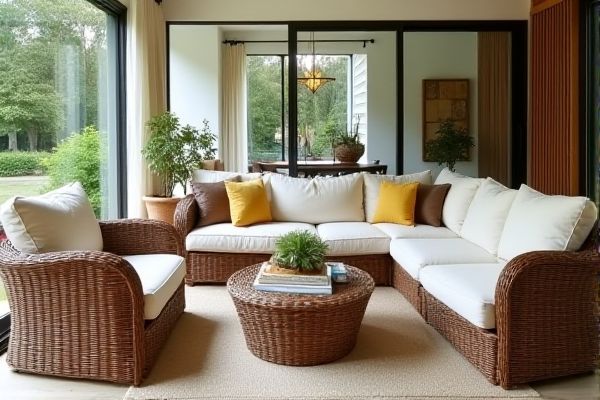
Synthetic wicker offers durability and resistance to moisture, making it ideal for outdoor furniture exposed to various weather conditions. Explore the rest of the article to discover how resin wicker compares and which option best suits your needs.
Table of Comparison
| Feature | Synthetic Wicker | Resin Wicker |
|---|---|---|
| Material Composition | Polyethylene fibers | Polyvinyl chloride (PVC) or polyethylene resin |
| Durability | Moderately durable, prone to UV fading | Highly durable, UV resistant |
| Weather Resistance | Good, but may fade or crack in extreme conditions | Excellent, resists moisture and UV damage |
| Maintenance | Requires regular cleaning and protection from harsh weather | Low maintenance, easy to clean |
| Appearance | Natural wicker look, softer texture | Sleek, uniform look with a glossy finish |
| Cost | Generally lower cost | Higher cost due to enhanced durability |
| Environmental Impact | Less eco-friendly, uses synthetic polymers | More eco-friendly options available, recyclable materials |
Introduction to Synthetic Wicker and Resin Wicker
Synthetic wicker and resin wicker are popular materials used in outdoor furniture due to their durability and weather resistance. Synthetic wicker is typically made from polyethylene or other plastic fibers woven tightly to mimic natural wicker, while resin wicker specifically refers to synthetic wicker crafted from resin-coated fibers that enhance UV protection and moisture resistance. Your choice between the two affects furniture longevity, maintenance needs, and aesthetic appeal in outdoor settings.
Defining Synthetic Wicker: Materials and Manufacturing
Synthetic wicker is crafted from polyethylene or other durable plastics designed to mimic natural rattan's texture and flexibility, achieved through extrusion and weaving processes. Resin wicker, a subtype of synthetic wicker, specifically utilizes high-density polyethylene (HDPE) resin, offering enhanced UV resistance and weather durability for outdoor furniture. Both materials undergo precision manufacturing techniques to ensure consistent quality, colorfastness, and resilience against moisture, fading, and cracking.
Understanding Resin Wicker: Composition and Process
Resin wicker is crafted from high-density polyethylene (HDPE) fibers, which are woven around a sturdy aluminum frame to create durable outdoor furniture. This synthetic material undergoes a multi-step extrusion process, incorporating UV inhibitors and colorants to enhance weather resistance and prevent fading. The result is a flexible, lightweight, and low-maintenance alternative to traditional wicker, ideal for outdoor settings.
Key Differences Between Synthetic and Resin Wicker
Synthetic wicker is a broad category of man-made fibers designed to mimic natural wicker, while resin wicker specifically refers to polyethylene fibers known for durability and UV resistance. Resin wicker is waterproof, fade-resistant, and ideal for outdoor furniture, whereas other synthetic wickers may not offer the same level of weather resistance. Understanding these key differences helps you choose the best material for furniture that withstands various environmental conditions.
Durability and Weather Resistance Comparison
Synthetic wicker and resin wicker both offer superior durability and weather resistance, making them ideal for outdoor furniture. Synthetic wicker, typically made from high-quality polyethylene fibers, resists UV rays, moisture, and temperature fluctuations, preventing cracking and fading over time. Your investment in resin wicker furniture ensures similar resilience due to its non-porous, waterproof characteristics, which withstand harsh weather conditions without deteriorating.
Aesthetic Appeal and Design Options
Synthetic wicker offers a natural, handcrafted appearance with intricate patterns that mimic traditional rattan, providing a timeless and elegant aesthetic for outdoor furniture. Resin wicker, made from polyethylene, delivers a sleek and uniform look with a wide range of colors and finishes, including matte and glossy options, allowing for versatile design customization. Both materials support various weaving styles and shapes, but resin wicker's durability and colorfastness make it ideal for modern, vibrant outdoor settings.
Maintenance Requirements and Care Tips
Synthetic wicker requires minimal maintenance, needing only regular dusting and occasional cleaning with mild soap and water to prevent dirt buildup. Resin wicker is highly durable and resistant to moisture, making it ideal for outdoor use with simple rinsing to maintain its appearance. To extend the life of your synthetic or resin wicker furniture, avoid prolonged exposure to direct sunlight and store cushions separately during inclement weather.
Environmental Impact and Sustainability
Synthetic wicker, typically made from petroleum-based plastics, has a higher environmental footprint due to non-biodegradable materials and energy-intensive manufacturing processes. Resin wicker, often crafted from polyethylene or recycled plastics, offers improved sustainability by incorporating recyclable components and resisting decay, which extends furniture lifespan and reduces waste. Both materials contribute to plastic pollution, but advancements in eco-friendly resin wicker production support greener outdoor furniture choices.
Cost Analysis: Which Is More Budget-Friendly?
Synthetic wicker and resin wicker both offer durable, weather-resistant options for outdoor furniture but differ notably in cost. Synthetic wicker typically costs less upfront due to its simpler manufacturing process, making it a budget-friendly choice for those seeking stylish yet affordable furniture. Your investment stretches further with synthetic wicker, providing an economical balance between quality and price for outdoor decor.
Choosing the Best Option for Your Outdoor Space
Synthetic wicker offers a natural look and texture, ideal for creating a cozy, organic atmosphere in your outdoor space. Resin wicker, made from high-quality polyethylene, provides superior durability, UV resistance, and is easy to maintain, making it perfect for harsh weather conditions. Selecting between synthetic and resin wicker depends on balancing aesthetic preferences with long-term durability and maintenance needs for your patio or garden furniture.
 homyna.com
homyna.com